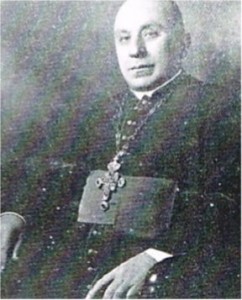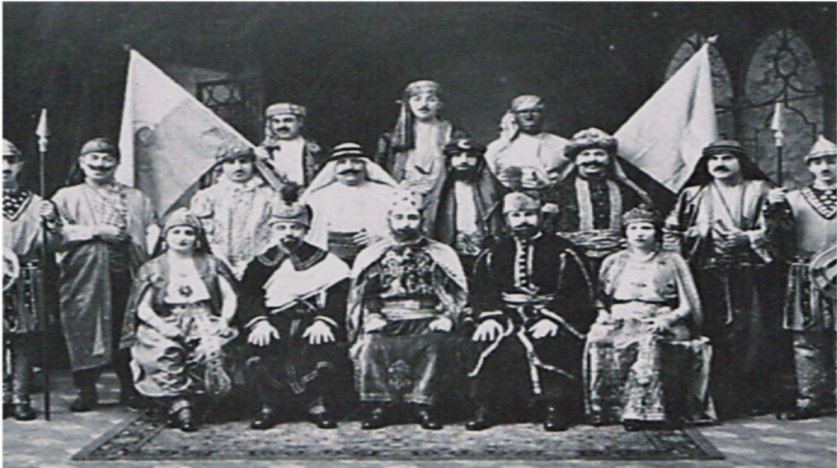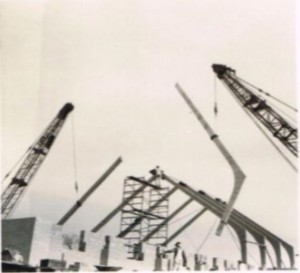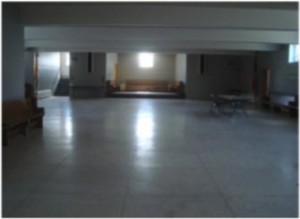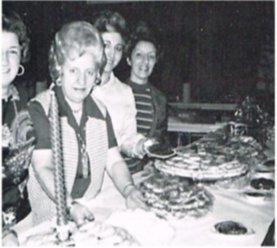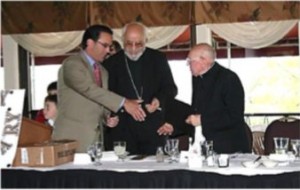Parish History

The pioneers who laid the foundations of St. Basil’s Church all came from Aleppo, in the northern part of Syria and 50 miles east of Antioch where the disciples were called Christians for the first time. In 1902, John Abboud Saman and his fellow Aleppians began to consider the feasibility of having their own church. These recent newcomers to America needed a place of worship that reflected their heritage and culture. For a time, most Aleppians frequented the Maronite Catholic Church built by Father Lotaif. Although there was a close kinship to the Maronites, there still remained a void for these Aleppians.
In 1913, Father Cyril Totongy, a Basilian Aleppian Melkite, visited Utica and was asked to remain to serve the Melkite community in Utica. At a meeting, The six pillars of the Aleppian Community: George Elias Casper -President, Bashir Elias Tehan Vice-President, Elias Srour- Secretary, Joseph Kassouf-Treasurer, George Fathalla Salem-Bookkeeper, Joseph Makames-Asst. Bookkeeper, took the responsibility of purchasing land for a church. Although more than $700 was collected from the community, Father Totongy did not possess the necessary credentials to enable him to serve the congregation. Despite being very disappointed, they continued their search for a qualified priest to serve their needs.
In 1914, in DuBois, Pa. Father Beshara Kayata, a Basilian Melkite from Damascus was serving a rather small community of Syrians. Soon after, Bishop Grimes granted the necessary papers and Father Kayata was temporarily allowed to offer the Sacrifice in the basement of St. John’s Church until a Melkite Church could be erected. It was at that time that the first trustees of St. Basil’s were chosen. They were Bashir Tehan, Elias Gazzal and Elias Srour.
In August of 1916, under the supervision of Joseph Makames and Abdalla Misri, the consecration of the ground took place, and shortly after the construction of the building began. Four thousand dollars was generously donated by neighboring Aleppian societies and the Utica community contributed $1,000 so that only the remaining funds would have to be borrowed. A mortgage was obtained from the Savings Bank for $4,500 with the approval of the Bishop of the Roman Catholic Syracuse Diocese. It was agreed that the basement of the church will be used as the church until the upper structure would be completed at a later date.
On December 21, 1917 the first liturgy was officiated by Msgr. Daniel Doody, assisted by Father Kayata. The church was named St. Basil the Great because its first pastor was a Basilian Monk.
Since there was no rectory, the priest lived with different families of the congregation for about five years. On July 25, 1923, a house at 531 Lansing St. was purchased to serve as a rectory, and by 1930 the church and the rectory were free of debts.
Reverend Kayata met his death on December 17, 1933 at the age of 66. Funeral services were held at St. John Church, where Bishop Duffy officiated. His body lays to rest at Calvary Cemetery near his old friend Father Lotaif, the Maronite priest who also served the Aleppian community for some time.
After the death of Father Kayata, the community began the process of finding a suitable replacement. Mr. Yorgyky Elias Chanatry headed the committee and began corresponding with the Latin Bishop and the Apostolic Delegate in order to obtain a pastor.
After much work, Father Peter Jeha, came to Utica but was only allowed a six month stay. Although the community desired to retain Father Jeha, he returned to Lebanon to continue his former duties. As Father Jeha left Utica, another priest, Father Justin Najme, a Basilian monk and an Aleppian, was granted permission for a two-month stay in Utica to serve the people. After having spent his allotted time in Utica, he returned home to the Monastery in Mt. Lebanon.
By 1935, St. Basil’s was without a priest. To rectify this situation Bishop Duffy obtained Father Paul Sayhoun, a Basilian Melkite, to serve the community; however, Father Sayhoun was not a native Aleppian and was rejected by the St. Basil community.
Archimandrite Alexious Shatawee was also rejected for the same reason. It is necessary to interject here that the refusal of these men signified the great love, admiration, devotion, respect and pride that these people had for their heritage. The bond that made these people such a workable unit was their shared heritage and they would permit nothing to break it.
Archimandrite Abdennour left Beirut on March 9, 1936 and arrived in Utica on April 2, 1936 and celebrated Palm Sunday Liturgy with his new parishioners. With the arrival of Father Abdennour, the community once again directed its energy toward completion of the church. At this time, however, the neighborhood that formerly seemed quiet was now too industrial, and did not satisfy most parish members. On November 5, 1937, it was agreed by those in charge to sell the old church and buy land that was more adaptable to the construction of a new church.
Mr. George Bally was chosen to serve as the chairperson for this major undertaking. On March 29, 1940, land at the corner of Rutger and Taylor Ave was purchased for $5,500. Bishop Walter Foery stipulated that construction could not begin unless $10,000 was secured, and the total cost of the building could not exceed $25,000. Despite these rigid stipulations, dedicated parishioners and community members sought out fundraising opportunities. On May 25, 1941 ground was broken and the site of the future church was blessed by Bishop Walter Foery.
Construction that seemed so imminent just a few years ago now seemed impossible because of World War II. In addition to these unfortunate circumstances, Archimandrite Abdennour died in April of 1947. Once again the church remained without a pastor.
In December of 1947 Father Julien Elaine became the new pastor of St. Basil Church. When resumption of the building plans were undertaken several years later, Father Elaine realized that the Rutger Street site would no longer serve as the most advantageous location, and through perseverance and foresight, acquired six lots from three different sources on Sherman Drive at Madison Ave and Armory Drive. This site has often been admired by both parish members and people of the community as one of the most ideal locations for a church in the Utica area.
On November 22, 1953, the cornerstone for the new church was laid and blessed by Auxiliary Bishop David F. Cunningham. On February 13, 1955, St. Basil’s was dedicated by Bishop Walter A. Foery of Syracuse, New York and the Pontifical Liturgy was celebrated by Archbishop Peter Chami of Hauran, Syria. Five years later on January 31, 1960 the mortgage was burned. A mortgage burning celebration was held, and its proceeds were used to help in the construction of a new rectory. The rectory was dedicated on Sunday November 26, 1961.
With the completion of the church and the rectory, St. Basil has not stood still in its structural pursuits. Countless improvements have been made to the church, rectory, auditorium, and landscape. The most significant changes are those in the sanctuary. St. Basil’s has adorned its interior with beautiful mosaics and marble altar accenting the Byzantine style. In 1980 the most distinctive addition that made the church truly Byzantine is the outstanding Iconostasis made of bronze with mosaic panels. These Icons were made by A. Pierotti & Co. of Pietrasanta, Italy.
Over the years, several clubs and organizations have helped maintain the ethnic spirit of St. Basil’s Church. The women of St. Basil’s past and present have devoted many hours to ensure the success of countless church affairs. Their unselfishness and love for St. Basil’s will never be forgotten.
St. Basil’s was blessed by having three of its members ordained to the service of the Melkite Catholic Church in the United States of America: Rt. Rev. Archimandrite Edward Kakaty; Rev. Fr. Richard Rasi and Rev. Deacon Daniel Klockowski. The Community of St. Basil was blessed by its two daughters who became Nuns: Mary Tahan joined the Sisters of Charity as Sister Rita and Florence Zaloom joined the Sisters of Saint Joseph of Carondelet.
The most significant event that has left its mark on St. Basil is the death of its tireless beloved pastor Rt. Rev. Archimandrite Julien Elaine on February 8, 2011, rendering St Basil’s Church without a pastor. For two years, Father John Ghaby served as temporary pastor. Father Gahby diligently entered a difficult situation in Saint Basil history, and he guided the parish until a permanent pastor was appointed. His efforts were greatly appreciated by the parish. On January 3rd of 2013 Fr. Saba Shofany assumed the duties as pastor of St. Basil as designated by His Excellency Bishop Nicholas Samra.
Since Father’s arrival he has embarked on reviving the parish population and overseeing many overdue church and rectory renovations. Fr. Shofany is a pioneer in that he is the parish’s first married priest.
Recognizing that St. Basil’s parishioners have gone through joys, trials and tribulations, credit should be given to the community. St. Basil has gone through a metamorphosis as have other churches in the area. The phenomenon of losing members to relocation, changing attitudes, Americanization and Latinization of the last 3 or 4 generations, intermarriage and complacency has plagued St. Basil Melkite Catholic Church. The fervor and vigor of the original six Aleppians and its past pastors still reside in the hearts and minds of St. Basil’s parishioners— no matter their origin.
*The History of Saint Basil Church was compiled from past historical writings authored by Mr. William Chanatry and augmented by Mr. Robert Zaloom.
Former Pastors
St. Basil Church honors the other priests who served the community as temporary priests: Rev. Father Cyril Totongy (1913), Rev. Father Peter Jeha (1933), Rev. Father Justin Najmy (1933-1934), Rev. Father Paul Sayhoun (1934), Rt. Rev. Archimandrite Alexious Shatawee (1935-1936) Rev. Father Jean Ghaby (2010-2012)


